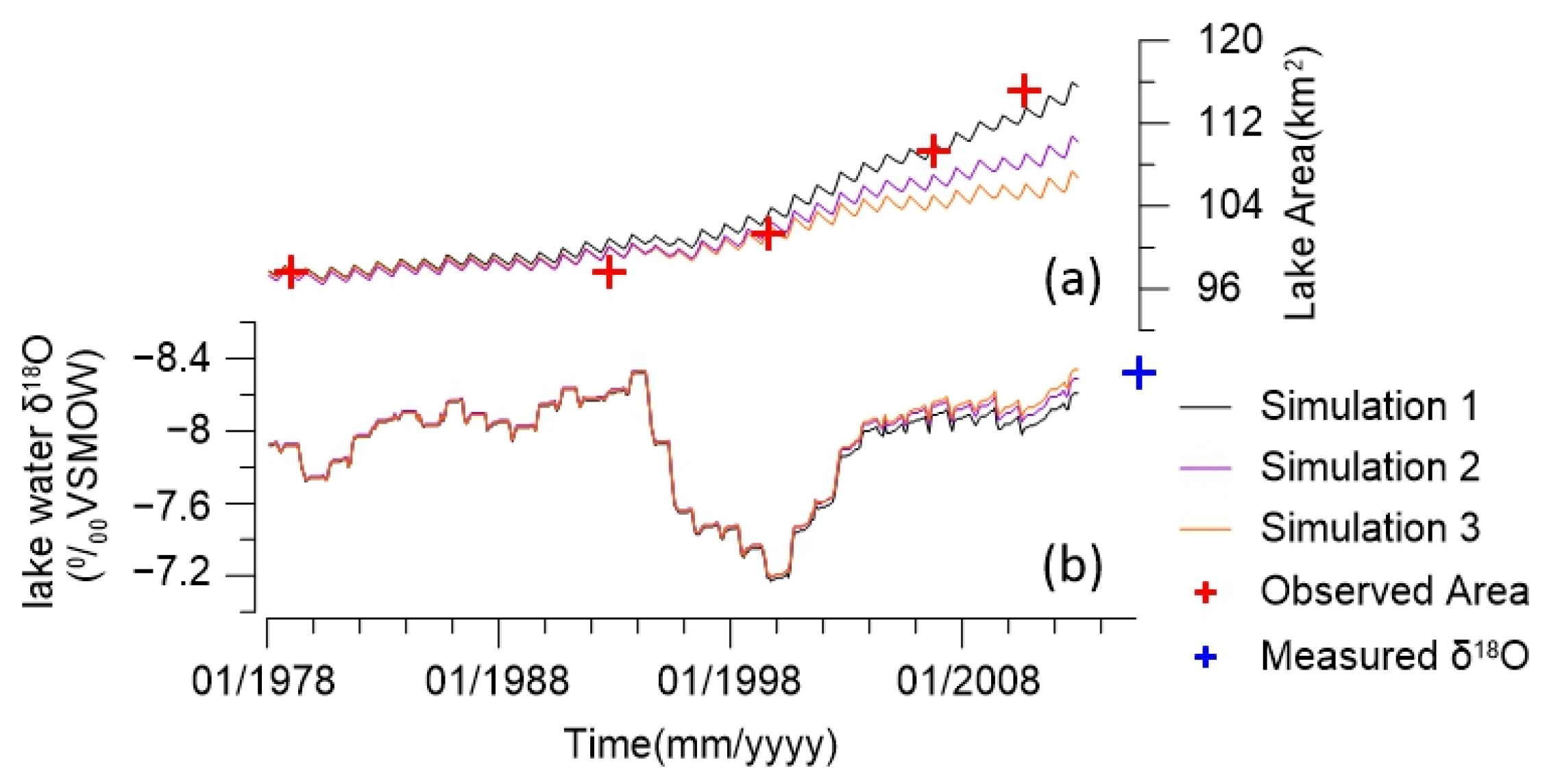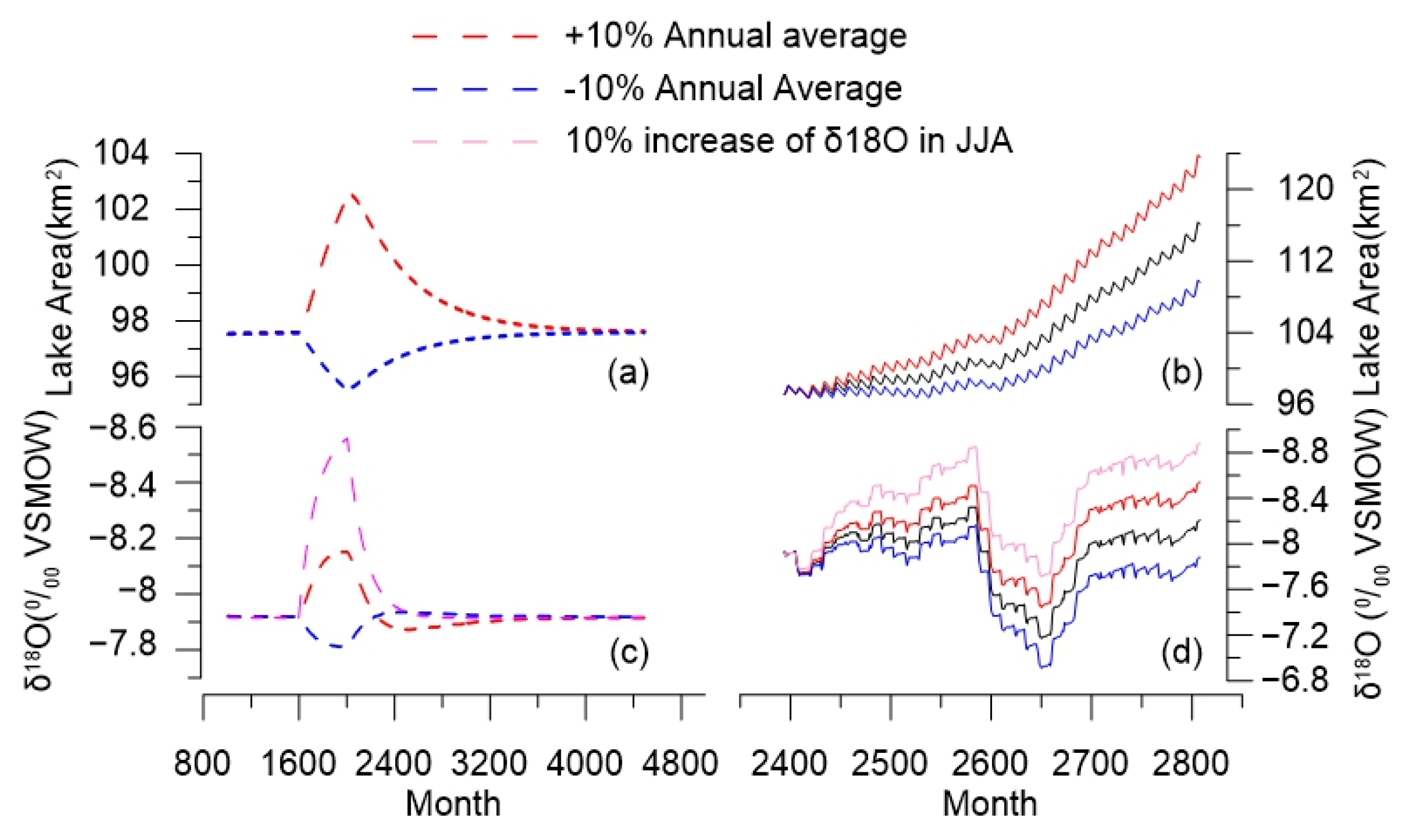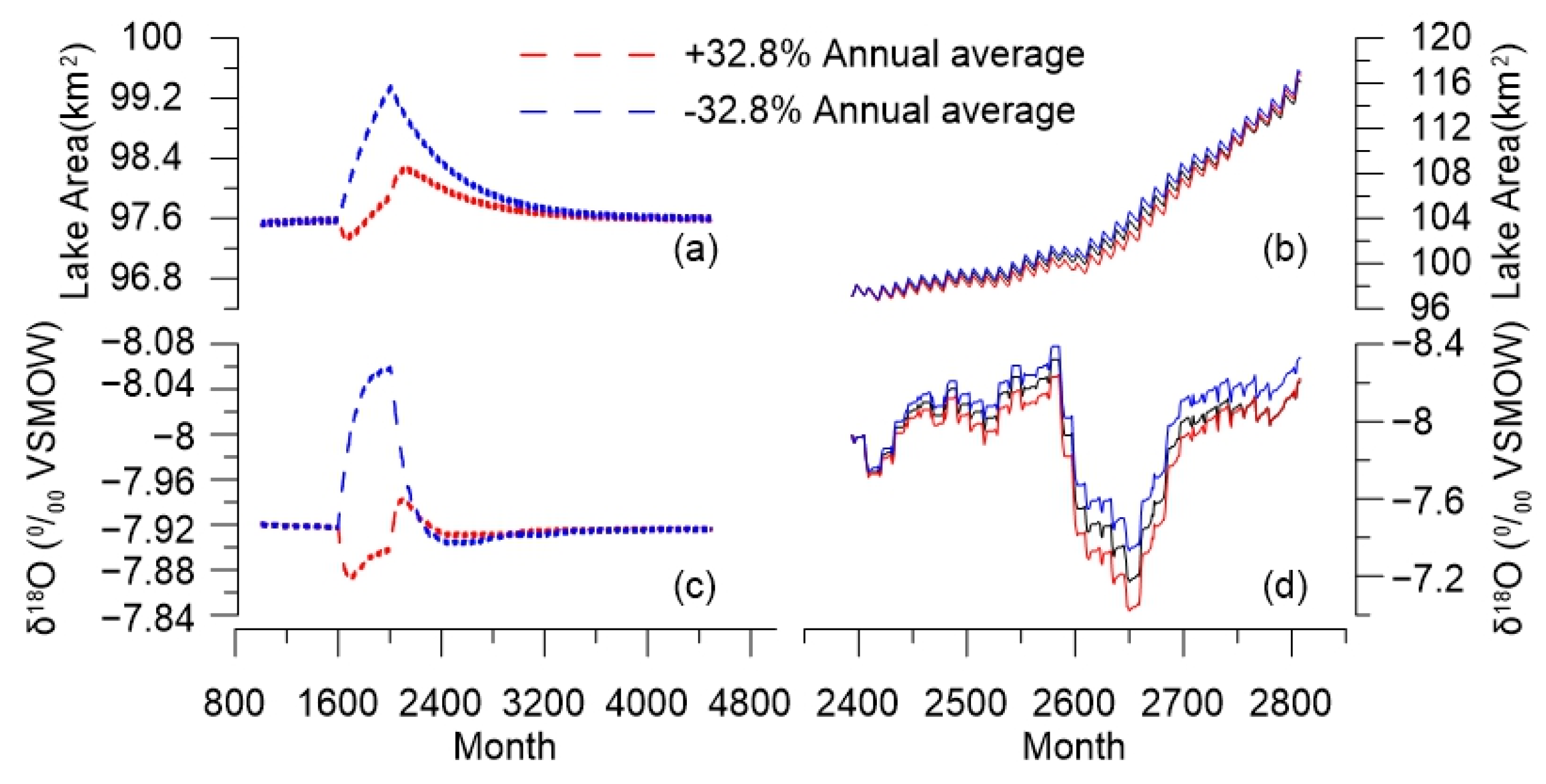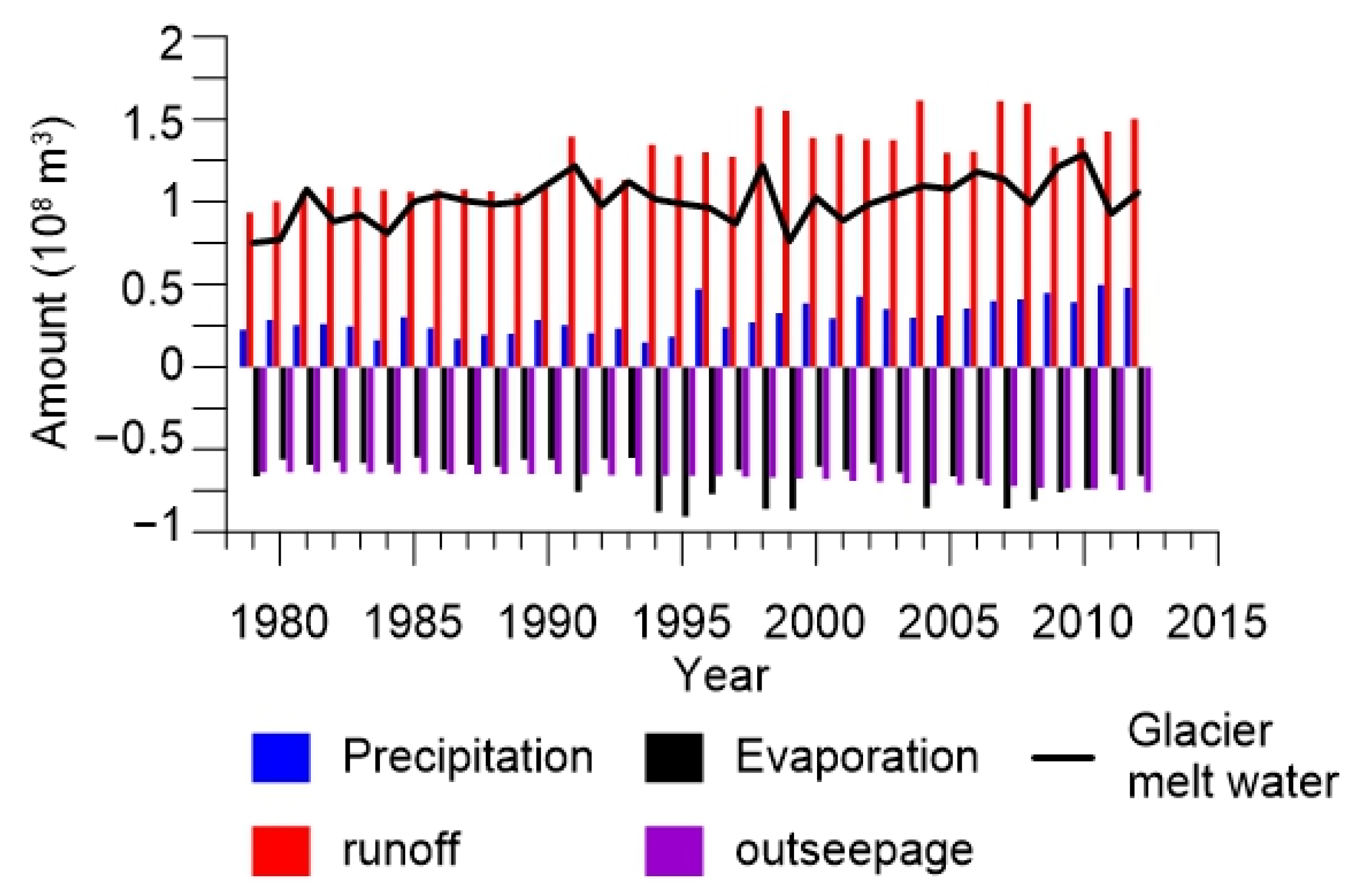Simulation of Hydrologic Change of Linggo Co during 1979–2012 Using Hydrologic and Isotopic Mass Balance Model
Abstract
:1. Introduction
2. Materials and Methods
2.1. Geological Settings
2.2. Data Source and Structure of the Model
2.3. Model Structure
2.3.1. Glacier Reservoir
2.3.2. Catchment Reservoir
2.3.3. Lake Reservoir
2.3.4. Isotope Mass-Balance Equations
2.3.5. Model Calibration and Sensitivity Analyses
3. Results
3.1. Model Calibration
3.2. Sensitivity Analysis of Model
4. Discussion
4.1. The Role of Glacier Melt to Lake Expand in Recent Decades
4.2. The Isotopic Response of Linggo Co to Temperature and Precipitation Amount
5. Conclusions
Supplementary Materials
Author Contributions
Funding
Data Availability Statement
Acknowledgments
Conflicts of Interest
References
- Yao, T.; Xue, Y.; Chen, D.; Chen, F.; Thompson, L.; Cui, P.; Koike, T.; Lau, W.K.-M.; Lettenmaier, D.; Mosbrugger, V.; et al. Recent Third Pole’s Rapid Warming Accompanies Cryospheric Melt and Water Cycle Intensification and Interactions between Monsoon and Environment: Multidisciplinary Approach with Observations, Modeling, and Analysis. Bull. Am. Meteorol. Soc. 2019, 100, 423–444. [Google Scholar] [CrossRef]
- Yao, T.; Bolch, T.; Chen, D.; Gao, J.; Immerzeel, W.; Piao, S.; Su, F.; Thompson, L.; Wada, Y.; Wang, L.; et al. The imbalance of the Asian water tower. Nat. Rev. Earth Environ. 2022, 3, 618–632. [Google Scholar] [CrossRef]
- Immerzeel, W.W.; Lutz, A.F.; Andrade, M.; Bahl, A.; Biemans, H.; Bolch, T.; Hyde, S.; Brumby, S.; Davies, B.J.; Elmore, A.C.; et al. Importance and vulnerability of the world’s water towers. Nature 2020, 577, 364–369. [Google Scholar] [CrossRef]
- Pritchard, H.D. Asia’s shrinking glaciers protect large populations from drought stress. Nature 2019, 569, 649–654. [Google Scholar] [CrossRef]
- Zhang, G.; Yao, T.; Xie, H.; Yang, K.; Zhu, L.; Shum, C.; Bolch, T.; Yi, S.; Allen, S.; Jiang, L.; et al. Response of Tibetan Plateau lakes to climate change: Trends, patterns, and mechanisms. Earth-Sci. Rev. 2020, 208, 103269. [Google Scholar] [CrossRef]
- Lei, Y.; Yao, T.; Yang, K.; Bird, B.W.; Tian, L.; Zhang, X.; Wang, W.; Xiang, Y.; Dai, Y.; Lazhu; et al. An integrated investigation of lake storage and water level changes in the Paiku Co basin, central Himalayas. J. Hydrol. 2018, 562, 599–608. [Google Scholar] [CrossRef] [Green Version]
- Tong, K.; Su, F.; Xu, B. Quantifying the contribution of glacier meltwater in the expansion of the largest lake in Tibet. J. Geophys. Res. Atmos. 2016, 121, 11158–11173. [Google Scholar] [CrossRef]
- Lei, Y.; Yao, T.; Bird, B.W.; Yang, K.; Zhai, J.; Sheng, Y. Coherent lake growth on the central Tibetan Plateau since the 1970s: Characterization and attribution. J. Hydrol. 2013, 483, 61–67. [Google Scholar] [CrossRef]
- Song, C.; Huang, B.; Richards, K.; Ke, L.; Phan, V.H. Accelerated lake expansion on the Tibetan Plateau in the 2000s: Induced by glacial melting or other processes? Water Resour. Res. 2014, 50, 3170–3186. [Google Scholar] [CrossRef] [Green Version]
- Lei, Y.; Yao, T.; Yi, C.; Wang, W.; Sheng, Y.; Li, J.; Joswiak, D. Glacier mass loss induced the rapid growth of Linggo Co on the central Tibetan Plateau. J. Glaciol. 2012, 58, 177–184. [Google Scholar] [CrossRef] [Green Version]
- Zhou, J.; Wang, L.; Zhong, X.; Yao, T.; Qi, J.; Wang, Y.; Xue, Y. Quantifying the major drivers for the expanding lakes in the interior Tibetan Plateau. Sci. Bull. 2022, 67, 474–478. [Google Scholar] [CrossRef]
- Zhu, L.; Xie, M.; Wu, Y. Quantitative analysis of lake area variations and the influence factors from 1971 to 2004 in the Nam Co basin of the Tibetan Plateau. Chin. Sci. Bull. 2010, 55, 1294–1303. [Google Scholar] [CrossRef]
- An, Z.; Colman, S.M.; Zhou, W.; Li, X.; Brown, E.T.; Jull, A.J.T.; Cai, Y.; Huang, Y.; Lu, X.; Chang, H.; et al. Interplay between the Westerlies and Asian monsoon recorded in Lake Qinghai sediments since 32 ka. Sci. Rep. 2012, 2, 619. [Google Scholar] [CrossRef] [Green Version]
- Zhu, H.; Huang, R.; Asad, F.; Liang, E.; Bräuning, A.; Zhang, X.; Dawadi, B.; Man, W.; Grießinger, J. Unexpected climate variability inferred from a 380-year tree-ring earlywood oxygen isotope record in the Karakoram, Northern Pakistan. Clim. Dyn. 2021, 57, 701–715. [Google Scholar] [CrossRef]
- Zhao, C.; Cheng, J.; Wang, J.; Yan, H.; Leng, C.; Zhang, C.; Feng, X.; Liu, W.; Yang, X.; Shen, J. Paleoclimate Significance of Reconstructed Rainfall Isotope Changes in Asian Monsoon Region. Geophys. Res. Lett. 2021, 48, e2021GL092460. [Google Scholar] [CrossRef]
- Rech, J.A.; Pigati, J.S.; Springer, K.B.; Bosch, S.; Nekola, J.C.; Yanes, Y. Oxygen isotopes in terrestrial gastropod shells track Quaternary climate change in the American Southwest. Quat. Res. 2021, 104, 43–53. [Google Scholar] [CrossRef]
- Steinman, B.A.; Pompeani, D.P.; Abbott, M.B.; Ortiz, J.D.; Stansell, N.D.; Finkenbinder, M.S.; Mihindukulasooriya, L.N.; Hillman, A.L. Oxygen isotope records of Holocene climate variability in the Pacific Northwest. Quat. Sci. Rev. 2016, 142, 40–60. [Google Scholar] [CrossRef] [Green Version]
- Leng, M.J.; Marshall, J.D. Palaeoclimate interpretation of stable isotope data from lake sediment archives. Quat. Sci. Rev. 2004, 23, 811–831. [Google Scholar] [CrossRef] [Green Version]
- Huang, X.; Oberhänsli, H.; von Suchodoletz, H.; Prasad, S.; Sorrel, P.; Plessen, B.; Mathis, M.; Usubaliev, R. Hydrological changes in western Central Asia (Kyrgyzstan) during the Holocene as inferred from a palaeolimnological study in lake Son Kul. Quat. Sci. Rev. 2014, 103, 134–152. [Google Scholar] [CrossRef]
- Bowen, G.J.; Kennedy, C.D.; Liu, Z.; Stalker, J. Water balance model for mean annual hydrogen and oxygen isotope distributions in surface waters of the contiguous United States. J. Geophys. Res. Atmos. 2011, 116, G04011. [Google Scholar] [CrossRef] [Green Version]
- Steinman, B.A.; Abbott, M.B. Isotopic and hydrologic responses of small, closed lakes to climate variability: Hydroclimate reconstructions from lake sediment oxygen isotope records and mass balance models. Geochim. Cosmochim. Acta 2013, 105, 342–359. [Google Scholar] [CrossRef]
- Steinman, B.A.; Rosenmeier, M.F.; Abbott, M.B. The isotopic and hydrologic response of small, closed-basin lakes to climate forcing from predictive models: Simulations of stochastic and mean state precipitation variations. Limnol. Oceanogr. 2010, 55, 2246–2261. [Google Scholar] [CrossRef] [Green Version]
- Steinman, B.A.; Rosenmeier, M.F.; Abbott, M.B.; Bain, D.J. The isotopic and hydrologic response of small, closed-basin lakes to climate forcing from predictive models: Application to paleoclimate studies in the upper Columbia River basin. Limnol. Oceanogr. 2010, 55, 2231–2245. [Google Scholar] [CrossRef] [Green Version]
- Liu, W.; Zhang, P.; Zhao, C.; Wang, H.; An, Z.; Liu, H. Reevaluation of carbonate concentration and oxygen isotope records from Lake Qinghai, the northeastern Tibetan Plateau. Quat. Int. 2018, 482, 122–130. [Google Scholar] [CrossRef]
- Yu, W.; Tian, L.; Ma, Y.; Xu, B.; Qu, D. Simultaneous monitoring of stable oxygen isotope composition in water vapour and precipitation over the central Tibetan Plateau. Atmospheric Meas. Tech. 2015, 15, 10251–10262. [Google Scholar] [CrossRef] [Green Version]
- Gao, J.; Masson-Delmotte, V.; Yao, T.; Tian, L.; Risi, C.; Hoffmann, G. Precipitation Water Stable Isotopes in the South Tibetan Plateau: Observations and Modeling. J. Clim. 2011, 24, 3161–3178. [Google Scholar] [CrossRef] [Green Version]
- Pan, B.; Yi, C.; Jiang, T.; Dong, G.; Hu, G.; Jin, Y. Holocene lake-level changes of Linggo Co in central Tibet. Quat. Geochronol. 2012, 10, 117–122. [Google Scholar] [CrossRef]
- Yi, C.; Li, X.; Qu, J. Quaternary glaciation of Puruogangri—The largest modern ice field in Tibet. Quat. Int. 2002, 97–98, 111–121. [Google Scholar] [CrossRef]
- He, Y.; Hou, J.; Brown, E.T.; Xie, S.; Bao, Z. Timing of the Indian Summer Monsoon onset during the early Holocene: Evidence from a sediment core at Linggo Co, central Tibetan Plateau. Holocene 2017, 28, 755–766. [Google Scholar] [CrossRef]
- Ma, N.; Zhang, Y.; Guo, Y.; Gao, H.; Zhang, H.; Wang, Y. Environmental and biophysical controls on the evapotranspiration over the highest alpine steppe. J. Hydrol. 2015, 529, 980–992. [Google Scholar] [CrossRef]
- Wang, W.; Xing, W.; Shao, Q.; Yu, Z.; Peng, S.; Yang, T.; Yong, B.; Taylor, J.; Singh, V.P. Changes in reference evapotranspiration across the Tibetan Plateau: Observations and future projections based on statistical downscaling. J. Geophys. Res. Atmos. 2013, 118, 4049–4068. [Google Scholar] [CrossRef]
- He, J.; Yang, K. China Meteorological Forcing Dataset. Cold Arid Reg. Sci. Data Cent. Lanzhou 2011, 10, 1–14. [Google Scholar] [CrossRef]
- Yang, K.; He, J.; Tang, W.; Qin, J.; Cheng, C.C. On downward shortwave and longwave radiations over high altitude regions: Observation and modeling in the Tibetan Plateau. Agric. For. Meteorol. 2010, 150, 38–46. [Google Scholar] [CrossRef]
- Maussion, F.; Scherer, D.; Mölg, T.; Collier, E.; Curio, J.; Finkelnburg, R. Precipitation Seasonality and Variability over the Tibetan Plateau as Resolved by the High Asia Reanalysis. J. Clim. 2014, 27, 1910–1927. [Google Scholar] [CrossRef] [Green Version]
- Thompson, L.G.; Tandong, Y.; Davis, M.E.; Mosley-Thompson, E.; Mashiotta, T.A.; Lin, P.-N.; Mikhalenko, V.N.; Zagorodnov, V.S. Holocene climate variability archived in the Puruogangri ice cap on the central Tibetan Plateau. Ann. Glaciol. 2006, 43, 61–69. [Google Scholar] [CrossRef] [Green Version]
- Wenjun, T. Daily Average Solar Radiation Dataset of 716 Weather Stations in China (1961–2010); National Tibetan Plateau/Third Pole Environment Data Center, Ed.; National Tibetan Plateau/Third Pole Environment Data Center; A Big Earth Data Platform for Three Poles: Beijing, China, 2015. [Google Scholar]
- Bowen, G.J.; Revenaugh, J. Interpolating the isotopic composition of modern meteoric precipitation. Water Resour. Res. 2003, 39, 1299. [Google Scholar] [CrossRef] [Green Version]
- Hock, R. Glacier melt: A review of processes and their modelling. Prog. Phys. Geogr. Earth Environ. 2005, 29, 362–391. [Google Scholar] [CrossRef]
- Zhang, G.; Kang, S.; Fujita, K.; Huintjes, E.; Xu, J.; Yamazaki, T.; Haginoya, S.; Wei, Y.; Scherer, D.; Schneider, C.; et al. Energy and mass balance of Zhadang glacier surface, central Tibetan Plateau. J. Glaciol. 2013, 59, 137–148. [Google Scholar] [CrossRef] [Green Version]
- Sun, W.; Qin, X.; Du, W.; Liu, W.; Liu, Y.; Zhang, T.; Xu, Y.; Zhao, Q.; Wu, J.; Ren, J. Ablation modeling and surface energy budget in the ablation zone of Laohugou glacier No. 12, western Qilian mountains, China. Ann. Glaciol. 2014, 55, 111–120. [Google Scholar] [CrossRef] [Green Version]
- Morton, F. Operational estimates of areal evapotranspiration and their significance to the science and practice of hydrology. J. Hydrol. 1983, 66, 1–76. [Google Scholar] [CrossRef]
- Ma, N.; Zhang, Y.; Szilagyi, J.; Guo, Y.; Zhai, J.; Gao, H. Evaluating the complementary relationship of evapotranspiration in the alpine steppe of the Tibetan Plateau. Water Resour. Res. 2015, 51, 1069–1083. [Google Scholar] [CrossRef] [Green Version]
- McMahon, T.A.; Peel, M.C.; Lowe, L.; Srikanthan, R.; McVicar, T.R. Estimating actual, potential, reference crop and pan evaporation using standard meteorological data: A pragmatic synthesis. Hydrol. Earth Syst. Sci. 2013, 17, 1331–1363. [Google Scholar] [CrossRef] [Green Version]
- Valiantzas, J.D. Simplified versions for the Penman evaporation equation using routine weather data. J. Hydrol. 2006, 331, 690–702. [Google Scholar] [CrossRef]
- Genereux, D.; Bandopadhyay, I. Numerical investigation of lake bed seepage patterns: Effects of porous medium and lake properties. J. Hydrol. 2001, 241, 286–303. [Google Scholar] [CrossRef]
- Craig, H.; Gordon, L.I. Deuterium and Oxygen 18 Variations in the Ocean and the Marine Atmosphere. In Symposium on Marine Geochemistry; Tonggiori, E., Ed.; University of Rhode Island Press: Spoleto, Italy, 1965; pp. 9–129. [Google Scholar]
- Gibson, J.; Prepas, E.; McEachern, P. Quantitative comparison of lake throughflow, residency, and catchment runoff using stable isotopes: Modelling and results from a regional survey of Boreal lakes. J. Hydrol. 2002, 262, 128–144. [Google Scholar] [CrossRef]
- Horita, J.; Wesolowski, D.J. Liquid-vapor fractionation of oxygen and hydrogen isotopes of water from the freezing to the critical temperature. Geochim. Cosmochim. Acta 1994, 58, 3425–3437. [Google Scholar] [CrossRef]
- Oosterbaan, R.J.; Nijland, H.J. Determining the Saturated Hydraulic Conductivity, in Drainage Principles and Applications; Ritzema, H.P., Ed.; International Institute for Land Reclamation and Improvement: Wageningen, The Netherlands, 1994; p. 18. [Google Scholar]
- Yao, T.D.; Thompson, L.; Yang, W.; Yu, W.S.; Gao, Y.; Guo, X.J.; Yang, X.X.; Duan, K.Q.; Zhao, H.B.; Xu, B.Q.; et al. Different glacier status with atmospheric circulations in Tibetan Plateau and surroundings. Nat. Clim. Chang. 2012, 2, 663–667. [Google Scholar] [CrossRef]
- Yang, K.; Ye, B.; Zhou, D.; Wu, B.; Foken, T.; Qin, J.; Zhou, Z. Response of hydrological cycle to recent climate changes in the Tibetan Plateau. Clim. Chang. 2011, 109, 517–534. [Google Scholar] [CrossRef]
- Zhang, X.; Ren, Y.; Yin, Z.-Y.; Lin, Z.; Zheng, D. Spatial and temporal variation patterns of reference evapotranspiration across the Qinghai-Tibetan Plateau during 1971–2004. J. Geophys. Res. Atmos. 2009, 114, 1–14. [Google Scholar] [CrossRef]
- Zhang, Y.; Liu, C.; Tang, Y.; Yang, Y. Trends in pan evaporation and reference and actual evapotranspiration across the Tibetan Plateau. J. Geophys. Res. Atmos. 2007, 112, D12110. [Google Scholar] [CrossRef]
- Yin, Y.; Wu, S.; Dai, E. Determining factors in potential evapotranspiration changes over China in the period 1971–2008. Chin. Sci. Bull. 2010, 55, 3329–3337. [Google Scholar] [CrossRef]
- Zhang, G.; Chen, W.; Li, G.; Yang, W.; Yi, S.; Luo, W. Lake water and glacier mass gains in the northwestern Tibetan Plateau observed from multi-sensor remote sensing data: Implication of an enhanced hydrological cycle. Remote Sens. Environ. 2019, 237, 111554. [Google Scholar] [CrossRef]
- Lister, G.S.; Kelts, K.; Zao, C.K.; Yu, J.-Q.; Niessen, F. Lake Qinghai, China: Closed-basin like levels and the oxygen isotope record for ostracoda since the latest Pleistocene. Palaeogeogr. Palaeoclim. Palaeoecol. 1991, 84, 141–162. [Google Scholar] [CrossRef]
- Liu, X.; Shen, J.; Wang, S.; Wang, Y.; Liu, W. Southwest monsoon changes indicated by oxygen isotope of ostracode shells from sediments in Qinghai Lake since the late Glacial. Chin. Sci. Bull. 2007, 52, 539–544. [Google Scholar] [CrossRef]
- Li, M.; Zheng, M.; Tian, L.; Zhang, P.; Ding, T.; Zhang, W.; Ling, Y. Climatic and hydrological variations on the southwestern Tibetan Plateau during the last 30,000 years inferred from a sediment core of Lake Zabuye. Quat. Int. 2023, 643, 22–33. [Google Scholar] [CrossRef]
- Yao, T.; Masson-Delmotte, V.; Gao, J.; Yu, W.; Yang, X.; Risi, C.; Sturm, C.; Werner, M.; Zhao, H.; He, Y.; et al. A review of climatic controls on δ18O in precipitation over the Tibetan Plateau: Observations and simulations. Rev. Geophys. 2013, 51, 525–548. [Google Scholar] [CrossRef]






| Simulation | Observsed Lake Area * | 1st | 2rd | 3th | |
|---|---|---|---|---|---|
| A | 39.35 | 1.17 | 0.013 | ||
| B | 0.0001 | 0.001 | 0.002 | ||
| Lake Area (km2) | Sep-1992 | 97.59 | 100.87 | 100.09 | 100.09 |
| Aug-1999 | 101.35 | 103.44 | 102.07 | 101.57 | |
| Sep-2006 | 109.33 | 110.1 | 107.01 | 105.03 | |
| Aug-2010 | 115.21 | 112.99 | 108.58 | 105.7 | |
| Mean MSD | 0.02 | 0.03 | 0.04 | ||
| Year | Precipitation on Lake (107m3) | Runoff into Lake (107 m3) | Evaporation (107 m3) | Outseepage (107 m3) | Glacier Melt (107 m3) | P-E in Catchment (107 m3) | Glacier Melt/Inflow * (%) |
|---|---|---|---|---|---|---|---|
| 1979 | 2.25 | 9.34 | 6.63 | 6.39 | 7.52 | 3.75 | 64.84 |
| 1980 | 2.86 | 10.02 | 5.63 | 6.37 | 7.70 | 3.20 | 59.82 |
| 1981 | 2.52 | 10.53 | 5.92 | 6.39 | 10.75 | 2.43 | 82.44 |
| 1982 | 2.61 | 10.87 | 5.76 | 6.40 | 8.80 | 2.33 | 65.29 |
| 1983 | 2.47 | 10.86 | 5.83 | 6.42 | 9.22 | 0.95 | 69.12 |
| 1984 | 1.63 | 10.70 | 5.88 | 6.43 | 8.09 | 1.46 | 65.57 |
| 1985 | 3.02 | 10.60 | 5.48 | 6.44 | 10.01 | 1.44 | 73.53 |
| 1986 | 2.36 | 10.71 | 6.24 | 6.46 | 10.43 | 0.19 | 79.82 |
| 1987 | 1.68 | 10.73 | 5.94 | 6.47 | 10.05 | 0.52 | 80.94 |
| 1988 | 1.92 | 10.63 | 6.01 | 6.47 | 9.84 | 0.18 | 78.41 |
| 1989 | 2.01 | 10.54 | 5.61 | 6.47 | 10.01 | 0.44 | 79.76 |
| 1990 | 2.85 | 10.83 | 5.59 | 6.49 | 11.09 | 3.72 | 81.03 |
| 1991 | 2.53 | 13.93 | 7.54 | 6.53 | 12.17 | 3.04 | 73.96 |
| 1992 | 2.05 | 11.40 | 5.56 | 6.55 | 9.76 | 0.00 | 72.56 |
| 1993 | 2.33 | 11.32 | 5.50 | 6.58 | 11.20 | 0.36 | 82.04 |
| 1994 | 1.49 | 13.46 | 8.77 | 6.59 | 10.15 | 0.00 | 67.86 |
| 1995 | 1.85 | 12.81 | 9.04 | 6.58 | 9.87 | 2.84 | 67.38 |
| 1996 | 4.74 | 12.99 | 7.68 | 6.60 | 9.64 | 19.19 | 54.42 |
| 1997 | 2.40 | 12.72 | 6.25 | 6.64 | 8.68 | 0.29 | 57.40 |
| 1998 | 2.71 | 15.73 | 8.61 | 6.69 | 12.18 | 5.73 | 66.02 |
| 1999 | 3.25 | 15.51 | 8.62 | 6.74 | 7.61 | 10.94 | 40.56 |
| 2000 | 3.84 | 13.88 | 6.03 | 6.80 | 10.26 | 6.46 | 57.94 |
| 2001 | 2.96 | 14.10 | 6.28 | 6.88 | 8.87 | 0.68 | 52.01 |
| 2002 | 4.27 | 13.77 | 5.86 | 6.95 | 9.88 | 5.78 | 54.74 |
| 2003 | 3.52 | 13.73 | 6.40 | 7.03 | 10.43 | 0.17 | 60.46 |
| 2004 | 2.97 | 16.14 | 8.54 | 7.09 | 10.96 | 3.70 | 57.37 |
| 2005 | 3.11 | 12.96 | 6.63 | 7.13 | 10.77 | 0.25 | 66.98 |
| 2006 | 3.54 | 13.02 | 6.81 | 7.17 | 11.81 | 5.73 | 71.30 |
| 2007 | 3.98 | 16.11 | 8.58 | 7.23 | 11.38 | 4.81 | 56.64 |
| 2008 | 4.09 | 15.97 | 8.09 | 7.30 | 9.89 | 0.69 | 49.29 |
| 2009 | 4.48 | 13.30 | 7.60 | 7.35 | 12.10 | 7.22 | 68.06 |
| 2010 | 3.91 | 13.88 | 7.39 | 7.40 | 12.90 | 3.48 | 72.51 |
| 2011 | 4.95 | 14.27 | 6.53 | 7.46 | 9.28 | 5.74 | 48.27 |
| 2012 | 4.79 | 15.01 | 6.58 | 7.55 | 10.56 | 12.77 | 53.35 |
Disclaimer/Publisher’s Note: The statements, opinions and data contained in all publications are solely those of the individual author(s) and contributor(s) and not of MDPI and/or the editor(s). MDPI and/or the editor(s) disclaim responsibility for any injury to people or property resulting from any ideas, methods, instructions or products referred to in the content. |
© 2023 by the authors. Licensee MDPI, Basel, Switzerland. This article is an open access article distributed under the terms and conditions of the Creative Commons Attribution (CC BY) license (https://creativecommons.org/licenses/by/4.0/).
Share and Cite
Zhang, X.; He, Y.; Tian, L.; Duan, H.; Cao, Y. Simulation of Hydrologic Change of Linggo Co during 1979–2012 Using Hydrologic and Isotopic Mass Balance Model. Water 2023, 15, 1004. https://doi.org/10.3390/w15051004
Zhang X, He Y, Tian L, Duan H, Cao Y. Simulation of Hydrologic Change of Linggo Co during 1979–2012 Using Hydrologic and Isotopic Mass Balance Model. Water. 2023; 15(5):1004. https://doi.org/10.3390/w15051004
Chicago/Turabian StyleZhang, Xueying, Yue He, Lijun Tian, Hanxi Duan, and Yifan Cao. 2023. "Simulation of Hydrologic Change of Linggo Co during 1979–2012 Using Hydrologic and Isotopic Mass Balance Model" Water 15, no. 5: 1004. https://doi.org/10.3390/w15051004
APA StyleZhang, X., He, Y., Tian, L., Duan, H., & Cao, Y. (2023). Simulation of Hydrologic Change of Linggo Co during 1979–2012 Using Hydrologic and Isotopic Mass Balance Model. Water, 15(5), 1004. https://doi.org/10.3390/w15051004







